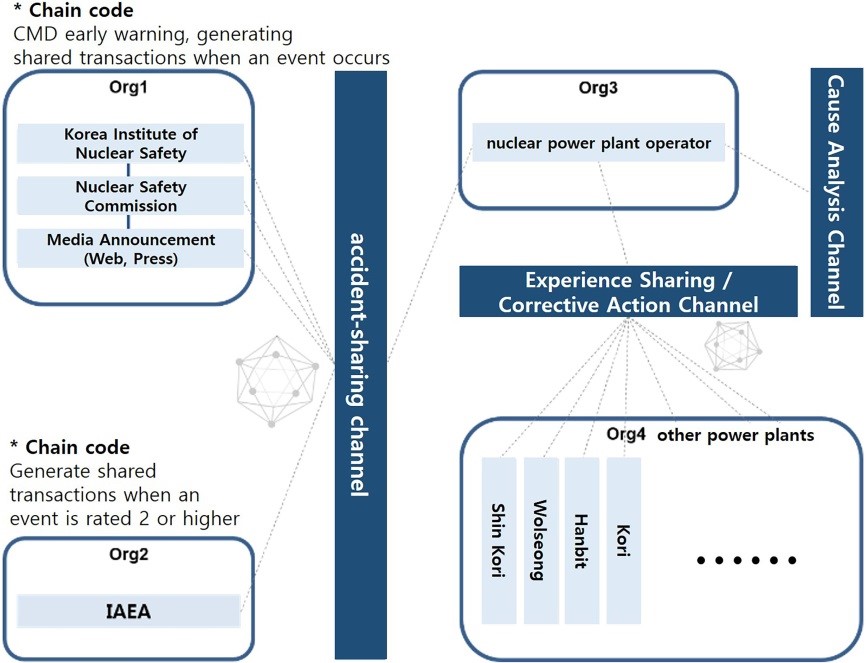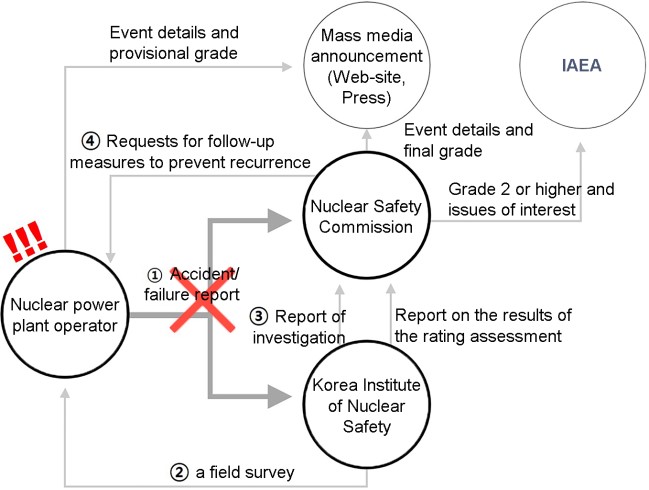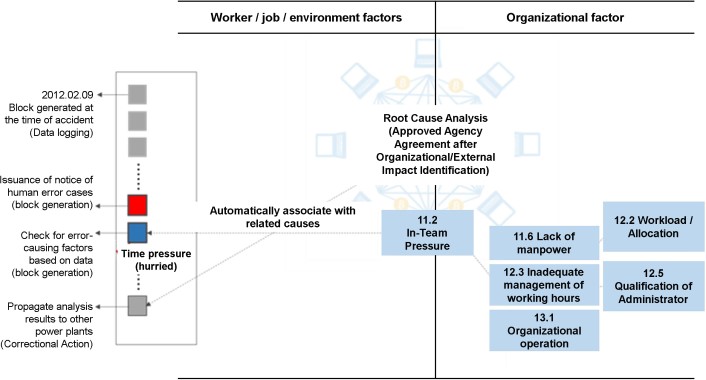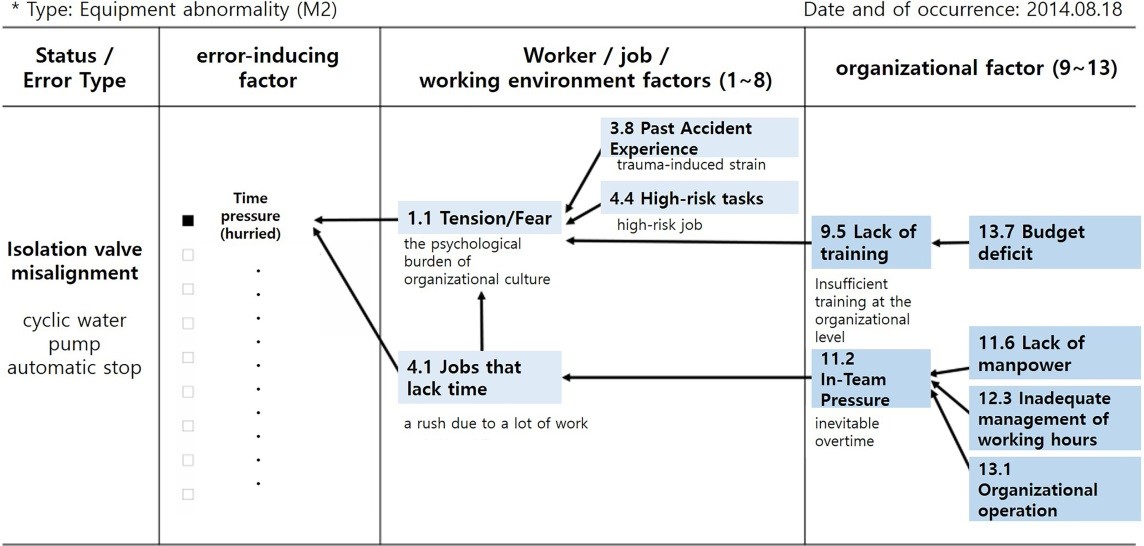eISSN: 2093-8462 http://jesk.or.kr
Open Access, Peer-reviewed

eISSN: 2093-8462 http://jesk.or.kr
Open Access, Peer-reviewed
Eun Gyeong Choi
, Woo Chang Cha
10.5143/JESK.2020.39.4.281 Epub 2020 September 01
Abstract
Objective:The purpose of this study is to propose the conceptual design for promoting the settlement of a transparent and fair safety culture through a blockchain-based system and ultimately secure the safety of large system such as nuclear power plants, railways, and aircraft.
Background: Human errors statistics in an operation of a largescale human machine system seems to be somehow inaccurate due to its' policy or culture of the system organization and stakeholders' interests. So the synthetic system process may be needed to show more reliable statistics of human errors in such a way to have more systematic approach.
Method: After identifying the current status of human errors, the safety culture and cause analysis process were studied to demonstrate the need to introduce innovative blockchain technology. And then the concept of hyperledger fabric blockchain was applied to the human errors situation in nuclear power plants to promote the development of more reliable human machine systems.
Results: The study result shows the feasible design of the conceptual architecture to be informed of human error statistics and share the information among the stakeholders. And it also shows the new possible approach to adapt human error management system within a whole system in more reliable and stable way.
Conclusion: Through a blockchain-based system, this case study prevents accident cover-ups in various fields with safety problems and presents solutions to improve problem situations by finding fundamental causes in terms of work environment and organizational culture.
Application: The results of this study can be used extensively in areas where public safety is essential. Through the application of the blockchain system, it would be expected to form a systematic thinking management ecosystem.
Keywords
Human error Accident Safety culture System engineering process Blockchain
최근 원전, 항공기 등 대형 시스템이 대부분 디지털화되면서 콘솔과 같은 디지털기기 사용환경의 안전성과 신뢰성이 다른 어떤 시스템보다도 강조되고 있다. 그러나 기술의 혁신으로 자동화, 지능화 등 기계시스템의 수준이 높아짐에 따라 인간 작업자의 인지적 오류가 발생하게 된다(Cha, 2013). Moon and Kim (2013)에 따르면 항공 분야에서 전반적인 사고 비율은 지난 몇 년 동안 상당히 감소하였고, 환경적 기계적 요소에 기인하는 사고는 줄었으나, 인적 오류는 항공 사고 원인 인자로 증가하고 있다. 이렇듯 항공 분야 뿐만 아니라 여러 산업 분야에서 인적 오류 사고는 여전히 큰 과제로 부각되고 있다. 인간의 작업 부하(workload), 자동화 기계에 대한 과도한 신뢰 등 여러 원인이 있겠지만 은폐의 메커니즘, 조직 및 문화적인 측면을 고려하여 인간에 의한 불량입력, 미흡한 인간 감시자 등 인간의 부적절한 행위 중 위반(violation)에 대해서 집중적으로 확인해 볼 필요가 있다. Lee(2013)은 조직의 위계 체계에서 아래로부터 위로 정보가 전달될 때 좋은 내용만 알려지고 나쁜 내용은 걸러지는 현상의 '침묵효과'에 대해 설명한다. 부정적인 정보 전달해주면 자신에게 불이익 올까 두려워, 불상사 예상해도 입을 닫는다며, 로버트슨 교수는 1986년 체르노빌 원자력발전소 폭발사건을 그 예로 들고 있다(Lee, 2013).
실제로 원자력발전소의 불시 정지와 케이블성적서 위조 사건, 원전 직원의 비리 등으로 원전 안전에 대한 국민의 불안감은 매우 높아져 원전 종사자의 높은 청렴성과 기본에 충실한 태도가 중요시된다(Jo, 2017). 현재는 사고의 발생 원인을 추적하는 과정에서 주로 운전자, 설계자 등 개개인의 잘잘못을 따져 책임을 물어 숨길 수밖에 없는 환경을 조성하게 되거나, 방어벽 문제나, 작업환경, 조직 문화 등 총체적인 구조 측면에서 안전 사고의 근본적인 원인을 분석할 수 있는 방안이 부족하기 때문에 빠르게 변화하는 디지털 환경에서 인적 오류를 분석하기 위한 프로세스를 체계적으로 정리하고, 실 문제점을 해결하기 위해서 블록체인 기반 시스템 설계 및 적용에 대해 소개하고자 한다.
2.1 Comparison of domestic and foreign human error statistics
대형 시스템 각 분야에서 인적 요인에 의한 사고 발생, 사고 은폐 가능성과 관련하여 국내와 해외 간의 인적 사고 발생 현황, 원인 구성 비율을 비교 분석하였다. 대형 시스템 세 분야의 인적 요인의 발생 비율과 관련한 국내외 비교 및 전체적인 내용은 Table 1과 같이 정리하였다.
각 데이터 간에 차이가 난다면 환경에 따라 사고 발생에 영향이 있는 것인지 혹은 국내외 중 어느 한 곳에서는 사건 발생의 보고가 제대로 이뤄지지 않을지도 모른다는 가능성 등을 가설로 세울 수 있다.
이를 뒷받침하기 위해 기사 내용을 인용하자면, 원전 사고에 대한 광범위한 데이터베이스를 제공하고 있는 국제원자력기구(IAEA)에 지난 해 보고된 사고 건수는 Figure 1에서 보다시피 1985년의 231건에 비해 크게 줄어든 것으로 나타났다. 하지만 이는 원전 안전이 개선된 것이 아니라 원전을 운용하는 국가들이 자발적인 보고를 기피하는 데서 기인한다고 <월스트리트 저널>이 원자력 기구 핵 시설 안전과 관계자의 말을 따 보도했다. 크고 작은 원전 사고는 일반에 알려진 것보다 훨씬 많다는 것이다(Ryu, 2007).
|
|
Domestic |
Overseas |
Note |
|
Nuclear |
Percentage of human error causes: 18% - (1978-2018) 137 out of
738 cases |
Percentage of human error causes: 80% - It's not just
an individual problem, it's |
Reduced number of nuclear accident reports worldwide (IAEA) |
|
Railway |
Percentage
of human error causes: 44% - (2011-2015) 34 total train accidents, difficult
to compare due to lack of samples (http://www.railsafety.or.kr) |
Percentage
of human error causes: 50% - Describes that a large percentage of passenger risk is the responsibility of |
Different standards from British RSSB |
|
Aircraft |
Percentage of human error causes: more than 48% - (1994-2013) Low sample count, different types make it
difficult to compare |
Percentage
of human error causes: 55% - (1996-2005) Need to update data, |
The number of air accidents continues |

2.2 Organizational and safety culture
따라서 국내외 인적 사고 통계 비율의 차이를 파악하기 위해 조직, 안전문화 측면으로 볼 때 일반적으로 세울 수 있는 가설은 정치적 이해를 고려한 상부의 지시나, 불이익의 두려움 등 수직적인 국내 기업 문화로 인해 사고 이력이 누락, 은폐될 수 있다는 점이다. 그 근거로 KORAIL 대상 조직문화유형 분석 논문의 내용에서 발췌한 내용 및 Figure 2를 보면 국내에서는 처벌 위주 인사제도 및 위계 지향 조직 문화가 조직 발전에 있어 부정적인 장애물 임을 알 수 있다. 반면, 미국의 경우 안전성이 확보되지 않은 경우에는 작업자가 스스로 작업에 참여하지 않거나 기관사의 자발적인 보고가 이뤄진다는 데에서 안전문화의식 자체에 차이가 있음을 확인할 수 있다(Ju and Jo, 2009).
이어서 사고 은폐와 조직 문화의 관계성에 대해 뒷받침할 수 있는 실제 국내 사례를 찾는 것이 효과적이라고 판단하였고, 국내의 원전 사고 비공개 사례를 간단히 도식화한 것이 Table 2이다. 사고 발생자가 인사 피해를 우려하는 것도 있지만, 상부에 보고를 했음에도 원전 안전 신화에 대한 부담감, 많은 조직이 관계된 운영과 관리 등 사실의 오픈을 우려하게 되는 폐쇄적인 문화 자체가 문제이다.실제로 Table 2의 사례 중 발전소장, 간부들이 논의를 통해 은폐하기로 결정한 고리1호기 전력공급중단 사건 관련 조사 내용에 따르면, 당시 발전소장은 비상발령 및 보고대상임을 인지하였으나 본사의 안전대책 발표, 국민 여론과 고리1호기 완벽 운영에 대한 심한 심적 부담과 두려움으로 인해 대내외 보고를 하지 않기로 하였다고 진술하였다(Nuclear Safety and Security Commission, 2012).

|
Date |
Facility |
Event |
Cover-up, Closed-door case |
|
84, 88 |
Wolseong - Unit 1 |
Coolant leak accident |
Cover-up until the 1988
parliamentary audit |
|
1996 |
Yeonggwang - Unit 2 |
Coolant leak |
Known after a few weeks of
environmental pollution in the surrounding area |
|
2002 |
Uljin - Unit 4 |
Customs break accident of steam
generator |
Shrinkage cover-up due to
simple leakage accident |
|
2003 |
Nuclear disposal site |
Preliminary report on the
site of the collection facility |
Unreleased for a month /
after pointing out a TV debate |
|
2004 |
Yeonggwang - Unit 5 |
Detection of radioactive material
leaks, and enforcement of re-activation |
A week's cover-up |
|
2005 |
Nuclear disposal site |
Site Survey Report at the
time of the referendum |
A four-year cover-up |
|
2012 |
Gori - Unit 1 |
12-minute total power outage |
Cover-up for 1 month,
Manipulate driving records |
2.3 Process for analyzing causes of human error accidents
국내외 산업계의 대표 인적 오류 분석 기법들을 적용하여 사고를 다룰 때 분석 담당자, Tool, 절차 등이 어떻게 다른지, 인적 사고 발생 비율의 차이에 어떻게 영향을 주는 지 확인해보고자 국내 한수원과 미국 원자력 발전 회사 세 군데를 간단하게 비교 분석한 표가 Table 3이다. 인적 사고를 당사자 소속 부서에서 분석하게 되는 국내 환경에서 미국 타사보다 사건을 은폐할 가능성이 높기 때문에 어느 정도 통계 자료의 차이를 뒷받침할 수 있는 근거가 된다.
|
|
KHNP |
Entergy |
Duke energy |
PVNGS |
|
Purpose |
Cause analysis, |
Cause analysis, |
Case investigation |
Case investigation, |
|
Tool |
K-HPES |
Human performance evaluation |
HURB Charter |
Performance worksheet |
|
Representative |
Incident inducer, department
in charge |
Separate cause analysis |
Human action review board |
Department head of incident
inducer |
3.1 The introduction of blockchain technology
국내외 통계 자료의 갭과 안전문화 및 프로세스 등을 종합했을 때 빈번한 은폐 사례, 안전 및 보안의 중요성, 폐쇄적인 환경이라는 특징을 가진 원전의 경우가 실제 문제와 가깝다고 판단하였고, 이 해결 방향을 잡기 위해 앞으로 사회의 패러다임이 될 블록체인 기술을 새롭게 적용시켜보았다. '원전 운영자가 장부의 모든 권한을 가지는 것이 아니라, 이해관계자의 목적에 맞도록 투명하게 사고 정보를 공유할 수 있는 P2P 네트워크 기반 사고 이력 관리 시스템'을 제안하며 그 목적은 다음과 같다.
(1) 투명성 제고: 인적 사고의 발생 정보 실시간 공유 시스템으로 사건의 발생과 동시에 타임스탬프처럼 기록이 남고 여러 주체가 알 수 있게 하여, 중간에서 사고를 은폐할 위험성이 사라짐
(2) 공정성, 신뢰도 제고: 서로 연결된 개인, 작업장, 조직 원인을 확인하여 개인만의 오류가 아님을 스스로 자각하고 근본적인 원인 개선을 위한 방향성 제시 가능
(3) 신속성, 효율성 제고: CAP(운영개선프로그램) 연계, 운전경험 반영(빅데이터) 등을 통해 시정조치 및 재발 방지
(4) 상황, 환경에 맞는 보고 프로세스 적용 가능: 블록 체인 기술 중 채널(Channel)이라는 개념을 이용해 각 허가된 참여자에 한해 어떤 정보는 오픈 공유하고, 보안 정보에 대한 프라이버시는 강화할 수 있다는 장점이 있음
한국수력원자력을 중심으로 감독기관, 규제기관, 핵 발전 관련 공기업, 인증기관, 국내외 시험, 검증기관, 납품업체(제작, 공급사) 등 매우 큰 구조로 구성되는 원전 산업계에는, 기본적으로 블록 체인 자체가 가진 투명성이라는 장점을 살리면서, 영업 기밀, 전문 영역이라고 둘러대며 은폐 사례가 발생해왔던 현 상황의 개선 방안으로 활용할 수 있는 컨소시엄 블록 체인 방식이 가장 적합하다고 판단된다.
하이퍼레저 패브릭(Hyperledger Fabric)은 리눅스 재단의 주도 하에 산업 간 블록체인 기술 발전을 위해 조직된 전 세계적인 오픈 소스 협업 활동이다. 금융, 뱅킹, 사물 인터넷, 공급망, 제조 및 기술 등 광범위한 분야에서 참여 중이며, 표준화된 개방형 엔터프라이즈급 분산 원장 프레임워크 및 코드 베이스 개발을 위해 노력하고 있다. 그 중에서도 하이퍼레저 패브릭은 초기에 IBM이 제공한 44,000여 줄의 코드를 바탕으로 현재는 전 세계 개발자들이 기술 개발에 참여, 가장 왕성하게 활동 중인 프로젝트이다. 허가형 프라이빗 블록 체인 형태로 개발되었으며 이더리움, 비트코인 등 누구나 참여할 수 있는 퍼블릭 블록 체인과는 달리 MSP (Membership Service Provider)라는 인증 관리 시스템에 등록된 사용자만이 하이퍼레저 패브릭 블록 체인에 참여할 수 있다. 하이퍼레저 패브릭은 실행(Execute), 정렬(Order), 검증(Validation)의 단계로 트랜잭션의 생성부터 합의까지 단계별로 분리하여 데이터가 처리된다(Yun, 2018).
3.2 Design concept of hyperledger based human error management system
큰 구조의 원전 산업계라도 비즈니스 이해관계에 맞는 조직 및 채널을 각각 형성하여 데이터의 기밀성을 제공하는 컨소시엄 블록 체인을 활용한다면 허가된 참여자에 한해 어떤 정보는 부분적으로 오픈 공유하고 또 어떤 정보는 프라이빗하게 처리할 수 있다. Figure 3은 컨소시엄 블록 체인의 한 종류인 '하이퍼레저 패브릭(Hyperledger Fabric)'의 컨셉을 적용시켜 작성한 연결 개념도이며, 원자력 산업계산업계 내 세부 역할 파악 및 원자력안전위원회고시 세부 사고보고 규정에 따라 원전 이해관계를 바탕으로 조직이 어떤 채널에 소속되어 있고, 어떻게 연결되어 있는지 파악할 수 있다.

3.3 Blockchain-based sharing system of accident occurrence
한수원 전 사이트, 원전종합상황실에 구축한 CMD (Centralized Monitoring & Diagnosis) 시스템에 블록체인 기술을 적용시켜 조기 경보 및 사고 발생 시에 블록이 생성되어 종합상황실에서 이해관계자 모두에게 오픈 가능한 정보가 실시간으로 공유되게끔 한다. 이 때 오픈 가능한 정보는 대국민 정보공개에 관한 규정을 따르고, 기밀성 정보는 소속 채널 간의 블록체인 합의 및 보증 정책에 따른다. 트랜잭션 내용(일시, 원인, 상황 등)은 사건 보고서 작성 지침에 따라 자동으로 기록되도록 한다. 사고 발생 시점 공유 시스템에 블록체인 기술을 적용했을 때의 효과는 Table 4와 같다. 많은 이해관계기관에 따라 같은 채널에 소속되어 있는 참여자(peer)들은 공동의 분산 원장을 가지고 데이터를 공유할 것이고, 훨씬 더 신속하고 경제적으로 각자의 역할을 다하며 사건을 처리할 수 있다.
|
AS-IS |
TO-BE |

|

|
|
º Verbal reporting
and notification in accordance with the emergency order reportingprocedure (Refer to the emergency contact network of the relevant agencies):
An inefficientsharing system that takes time to verify content and conduct field surveys. º Possible cover-up or
omission ofincident reports, depending on circumstances, during multiple stages. |
º Sharing in realtime
to interested parties in the nuclear power plant industry: Rapid on-siteinvestigation and response are possible. And increase efficiency
with'channel' that shares content in part depending on the security importance ofinformation º Hashed values, real-time data,
and timestamps are recorded in the block chain to prevent forgery and tampering of documents. º As a result, increased transparency. |
3.4 Blockchain-based root cause analysis system
원인 분석, 운전경험자료 수집, 안전조치 기준, 훈련을 위해 한수원 자체적으로 실시하는 인적 사고 근본 원인 분석 프로세스는 분석 담당자의 기본지식이나 사건 이해 수준에 따라 개인별로 편차가 있을 수도 있다는 점에서 객관성이 떨어질 수 있고, 원래 인적 행위분석은 책임 규명이 아니라 시정조치에 우선을 둬야 하지만 심리적 상태, 조직 문화를 바탕으로 봤을 때 사건 당사자의 부담감이 생각보다 크다. 따라서 HEAR(철도-인적 오류 분류 체계)의 원인요소를 바탕으로 블록 체인의 체인코드 개념을 적용시켜 개인, 직무, 작업 환경, 조직적 요인을 함께 고려, 즉 개인만의 책임이 아니라는 것을 강조할 필요성이 있다. 체인코드의 로직은 HEAR의 개념이 바탕이 되어, 하나의 원인을 체크하면 관련 요인(개인, 직무, 작업환경, 조직적 요인)들을 순차적으로 연결시켜 결국 근본적인 원인을 도출해내는 것이다. 대부분의 인적 행위는 조직적인 요인이 근본적인 원인으로 작용할 가능성이 높다. 블록 체인 기반 근본 원인 분석 시스템의 효과는 Table 5와 같다.
Figure 4의 예시를 보면 익명의 운전원 A가 인적 행위에 관한 통지를 발행했을 때, 필수 입력사항(통지 제목, 유형, 작성 동기, 상세 내용, 발견 일시 등)들이 분산 원장에 생성되어 자동으로 기록되고, 단지 '시간 압박(서두름)'이라는 인적 오류 유발 인자를 하나 체크했을 뿐인데, 체인코드 로직에 의해 시간 압박 인자는 긴장/두려움이라는 개인적, 심리적인 요인에서부터 팀 내에 압력이 있었을 지도 모른다는 상황, 인력 부족 및 근무시간 관리가 미흡했던 부분까지, 즉 업무량이나 관리 감독자의 자격 및 조직적인 요인까지 연결이 되는 것을 눈으로 확인할 수 있다.
|
AS-IS |
TO-BE |

|

|
|
º Human Behavior
Analysis Process (Information Collection): There is a possibility that
individual interviews, physical evidence, and personnel may vary from person
to person. º In the process
of identifying error-causing factors, there is no variety of choices, and
simply checking them with a focus on personal errors (Resiliently, the cause
of the accident becomes increasingly unclear). º Although the CAP is Web-based, the
human behavior analysis sheet is entered directly into the documented format
and then attached to the file (Inefficient in reflecting driving experience
data) |
º Chain code
(Smart Contract): Automatically connect personal/workshop/organizational
causes in the process of deriving the root cause, helping to realize that it
is not just an individual's fault, such as a party to an incident, analyst,
or reference to driving experience data. º Reflects Big Data-Based Driving
Experience: Effectively referring to data written to the block chain for
improvement |

본 연구에서는 사례 연구, 문헌적 검토를 통해 원자력발전소, 철도, 항공기 세 분야에서의 국내외 인적 사고 현황과 실상 파악, 안전 문화와 인적 오류의 비교 분석을 통해 원자력산업 분야에 대해 블록 체인 개념 도입의 필요성을 제시하였다.
인사 피해를 우려한 사고 당사자이건, 정치적 이해를 고려한 해당 부서장이건, 기업의 이미지를 생각하는 임원진이건, 인적 사고 원인을 어느 누군가의 책임으로 보는 문화 자체로 인해 원자력 산업계에는 문제가 많았고, 이 악순환을 깨기 위해 안전 문화 인식 자체를 바꾸는 것이 필수적이다. 따라서 신속하고 투명하게 기록된다는 점과 함께 각 채널의 관리, 체인코드를 통해 조직적인 이유를 도출하여 근본적인 문제를 없애야 한다. 따라서 많은 활용성을 가진 블록 체인 기술로 효율적인 관리 프로세스를 만들고자 하였다.
대형 시스템 내 블록 체인의 도입 및 적용은 탈 중앙화로 인한 권력 분산, 보안 및 암호화로 정보의 신뢰성 상승, 이해 당사자들 간의 정보 공유 효율성 증대, 기록 절차 시간 및 비용 절감 등의 강점이 있기에, 사고 관리 체계에 효율적으로 기여하게 될 것이다.
블록체인 기반 인적 사고 공유를 통해 투명성을 높이고, 개인에 초점이 맞춰져 있던 인적 오류를 작업환경이나 조직적인 관점으로 접근함으로써 궁극적으로는 혁신 지향적인 문화, 깨어 있는 안전 문화의 정착에 도움을 주고자 하였다. 아직은 개념, 적용단계이지만 추후 이 시스템을 도입하여 원자력 발전 분야 전체에서 인적 사고 관리 생태계를 형성하게 되길 기원하고, 이후 많은 분야에서 시스템을 적용시켜 공공안전에 기여하는 장기적인 과제를 달성하기 위해서는 불명확한 법제도, 정치적 한계, 부재한 보상지급 등에 관한 체계적인 구축 방안과 계획을 마련할 필요가 있다.
References
1. Cha, W., Cognitive Systems Design, Kaos Book, 2013.
Crossref
2. Han, J. and Hwang, Y., A Study on the Policy Directions for the Prevention of Air Accidents, Report, 2013.
Crossref
3. IAEA (International Atomic Energy Agency), Nuclear Energy Series Report, No.NG-T2.7, 2013.
4. Jo, W., A Study of Human Error Performance Shaping Factors for Electrical Equipment on Nuclear Power Plant, thesis, 2017.
5. Ju, H. and Jo, J., Analyzing the Types of Organizational Culture apply to the Organizational Culture Assessment Instrument (OCAI): Focused on the KORAIL, KIPA. 18(3), 3-23, 2009.
Crossref
6. KAIST, Final Report on the 6th of Education and Training System for Safety Workers, 2010.
Crossref
7. Lee, G., The Korean Economy News, Block bad news from your boss… Silence effect that kills tissue, 2013.
8. Lee, K., Aviation Safety and Human Factors, 2008.
Crossref
9. Moon, W. and Kim, W., Establishing the Importance Institution for Prevention of Human Error, Journal of Advanced Navigation Technology, 17(4), 377-385, 2013.
Google Scholar
10. NEWSTAPA, A Special Issue Apocalypse of Nuclear Power Plant, 2014.
Crossref
11. Nuclear Safety and Security Commission, Investigation status and future measures related to the power supply interruption of Gori Unit 1, Report, 2012.
12. OPIS (Operational Performance Information System for Nuclear Power Plant) Web-page, http://opis.kins.re.kr
Crossref
13. Railway Safety Information Management System Home page, http://www.railsafety.or.kr, KOTSA (Korea Transportation Safety Authority), Railway Safety White Paper (2011-2015), 2016.
14. RSSB, Annual Safety Performance Report, 2010.
Crossref
15. Ryu, J., Hankyeore News, "There are many cases of concealment of nuclear accidents, 2007.
Crossref
16. Yun, D., A Blockchain that learns through the Hyperledger Fabric, Jpub, 2018.
Crossref
PIDS App ServiceClick here!